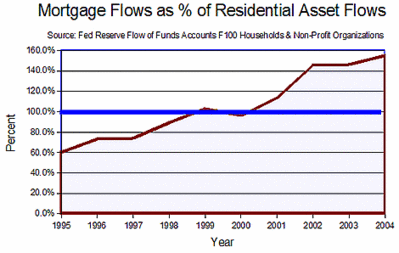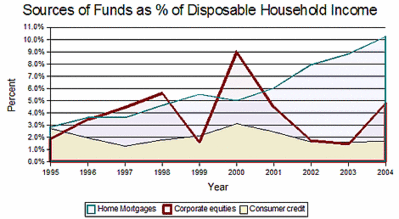Homes Are America’s Piggybanks
Posted By John Schroy On 25th January 2006 @ 10:07 In Individual Investors | Comments Disabled
For most Americans, owning a home is the principal means of saving for the future. However, this does not sway economists when calculating the ‘personal savings rate’.
(See: “[1] Do Negative Savings Rates Really Matter?”)
Over the last decade, Americans have gradually increased their level of mortgage borrowing from 60% of new investment in residential real estate to over 150%. In other words, individuals have been cashing out on the equity in their homes and taking the money for other purposes.
The graph shows this trend:
 Mortgages Outpace Homebuying
|
||
Some profess to see this as a sign of economic profligacy and an increasing ’spendthrift’ mentality.
However the evidence is otherwise.
Is Borrowing on Home Equity Good or Bad?
Many regard borrowing on home equity as an indication of economic desperation or imprudence. The popular goal is to own a home ‘free and clear’.
Does taking on a second mortgage signal a lack of financial control or hard times, something one does only when losing a job while still needing to pay a child’s college tuition or life-saving medical procedure?
This March 31, 2020 headline in [2] CNNMoney.com warns of the risks of spending home equity:
“Are you blowing your home equity?“
“Debt for lines of credit jumped 39 percent last year. Don’t let equity become a license to spend.“
In the article, Keith Gumbinger, vice president of HSH Associates, worries, “For some people a home equity line of credit is a brand new shovel for digging themselves further into debt.”
Is Building Home Equity A Form of Saving?
The presumption is that home equity is not a form of saving, like a bank account, to be used on a ‘rainy day’, but rather a sacred trust, to be nurtured, increased, and passed on to ungrateful heirs (or the government).
However, a legitimate use of savings is to spend money set aside for a ‘rainy day’ when needed. For most people, that rainy day eventually comes, unless one dies young or is born rich.
When that ‘rainy day’ arrives, there are emotional costs in drawing down on any ’savings’, whether in the form of a bank account, home equity, or family heirlooms — because, in the last analysis, in doing so, we become poorer.
Relatively few people are able to live through old age or sickness and still see their wealth increasing.
The United States is a rich country, but a large segment of the population could not survive on savings for more than a few months, requiring assistance from others. Net financial wealth of the entire country, including the Super-Rich, could only support current rates of consumption for three years.
(See: [3] Rich and Poor.)
To most people who expect to live to old age, a loan on home equity that pays for a trip to Cancun or a new powerboat might seem imprudent.
However, until we have statistics on who is borrowing on home equity and how the money is being used, we cannot know whether the practice is good or bad.
Consumer Borrowing in Perspective
After current income, the three principal sources of funds for American households are mortgage borrowing, equity sales, and consumer loans.
A large portion of equity sales are linked to employee options, and therefore should be considered a form of income.
(See: “[4] Extraordinary Capital Flows Inflate Equity Prices“).
However, the graph shows that consumer loans, mostly linked to credit cards, have fluctuated between 1% and 3% of disposal household income over the last decade — with no upward trend suggesting that Americans have become a ’spendthrift’ nation.
Equity borrowing on homes, however, has grown significantly, from 3% to over 10% of disposable household income. If there is any justification for claims of increased profligacy, this would seem to be prime evidence.
 Mortgages Fund Household Spending
|
||
Long-Term Trends in Home Prices
During the period 2001-2005, years in which many proclaimed a ‘real estate bubble’, American’s equity in their homes held more or less constant, fluctuating between 56.1% and 58.2%
(See: Federal Reserve Flow of Funds Table B.100, “[5] Balance Sheet of Households and Nonprofit Organizations“).
This suggests that Americans are not “blowing” their home equity, as the CNNMoney.com article suggests, but rather only taking advantage of low interest rates and rapidly increasing home values to transfers some assets in the ‘piggy bank’ of home equity into other forms of assets.
If fact, the [6] Flow of Funds table F100 for Q3 2005, suggests that at least some of this money is going into time and savings deposits, mutual fund shares, money market fund shares, and agency bonds.
Now this might be worrisome, if there indeed was a real estate bubble that was about to burst, resulting in a drastic reduction in the equity that Americans hold in their homes.
However, except for specific areas, the general expectation is not that nationwide home prices will crash, but only that the rate of price increases will slow down.
Over the last three decades, home prices increased, on average, 5.9% a year, sometimes rising over 14% and sometime holding steady, but never falling below the value of the previous year.
There are three reasons for this long-term increase in residential home values in the United States:
- Inflation: The cost of lumber, plumbing fixtures, and almost everything else that goes into building a house has increased over the years, with inflation.
- Population Growth: Over the long-term, the U.S. population has steadily increased, putting greater pressure on land values and inflating the value of real estate.
- Improved Product: Although some may become weepy with nostalgia for the ‘craftsmanship’ of American builders of yesteryear, American homes today are better and more practical as shelter than homes of the past. Few homes of the 1950s had walk-in closets, smoke-detectors, three-and-a-half baths, or effective protection against unwanted heat transfer as do today’s homes — which are also larger that models offered GIs in Levittown after World War II.
The graph in the article “[7] Is There a Real Estate Bubble?” shows how home values have risen by varying rates over the years, without having fallen into negative territory.
Therefore, although in certain parts of the country and among certain groups of people, there are those who are “blowing” their home equity, the evidence does not seem to support the contention that this is a generalized pattern of behavior.
Article printed from Capital Flow Watch: http://capital-flow-analysis.com/capital-flow-watch
URL to article: http://capital-flow-analysis.com/capital-flow-watch/homes-are-americas-piggybanks.html
URLs in this post:
[1] Do Negative Savings Rates Really Matter: http://capital-flow-analysis.info/capital-flow-watch/archives/52
[2] CNNMoney.com: http://money.cnn.com/
[3] Rich and Poor: http://capital-flow-analysis.info/investment-tutorial/lesson_12b.html
[4] Extraordinary Capital Flows Inflate Equity Prices: http://capital-flow-analysis.info/capital-flow-watch/archives/51
[5] Balance Sheet of Households and Nonprofit Organizations: http://www.federalreserve.gov/releases/Z1/Current/accessible/b100.htm
[6] Flow of Funds table F100 : http://capital-flow-analysis.info/flow-of-funds/F100.htm
[7] Is There a Real Estate Bubble?: http://capital-flow-analysis.info/investment-resources/properties.html#bubble
[8] home equity: http://capital-flow-analysis.com/capital-flow-watch/index.php?tag=home-equity
[9] home mortgages: http://capital-flow-analysis.com/capital-flow-watch/index.php?tag=home-mortgages
[10] savings rate: http://capital-flow-analysis.com/capital-flow-watch/index.php?tag=savings-rate
[11] Image: http://www.blinkbits.com/bookmarklets/save.php?v=1&source_url=http://capital-flow-analysis.com/c
apital-flow-watch/homes-are-americas-piggybanks.html&title=Homes+Are+America%27s+Piggybanks&body=Homes+Are+America%27s+Piggybanks
[12] Image: http://www.blinklist.com/index.php?Action=Blink/addblink.php&Description=&Url=http://capital
-flow-analysis.com/capital-flow-watch/homes-are-americas-piggybanks.html&Title=Homes+Are+America%27s+Piggybanks
[13] Image: http://blogmarks.net/my/new.php?mini=1&simple=1&url=http://capital-flow-analysis.com/capital
-flow-watch/homes-are-americas-piggybanks.html&title=Homes+Are+America%27s+Piggybanks
[14] Image: http://co.mments.com/track?url=http://capital-flow-analysis.com/capital-flow-watch/homes-are-america
s-piggybanks.html&title=Homes+Are+America%27s+Piggybanks
[15] Image: http://www.connotea.org/addpopup?continue=confirm&uri=http://capital-flow-analysis.com/capital-f
low-watch/homes-are-americas-piggybanks.html&title=Homes+Are+America%27s+Piggybanks
[16] Image: http://del.icio.us/post?url=http://capital-flow-analysis.com/capital-flow-watch/homes-are-americas-p
iggybanks.html&title=Homes+Are+America%27s+Piggybanks
[17] Image: http://de.lirio.us/rubric/post?uri=http://capital-flow-analysis.com/capital-flow-watch/homes-are-ame
ricas-piggybanks.html;title=Homes+Are+America%27s+Piggybanks;when_done=go_back
[18] Image: http://digg.com/submit?phase=2&url=http://capital-flow-analysis.com/capital-flow-watch/homes-are
-americas-piggybanks.html&title=Homes+Are+America%27s+Piggybanks
[19] Image: http://cgi.fark.com/cgi/fark/edit.pl?new_url=http://capital-flow-analysis.com/capital-flow-watch/hom
es-are-americas-piggybanks.html&new_comment=Homes+Are+America%27s+Piggybanks&new_comment=http%3A%2F%2Fcapital-flow-analysis.com%2Fcapital-flow-watch&linktype=Misc
[20] Image: http://feedmelinks.com/categorize?from=toolbar&op=submit&url=http://capital-flow-analysis.co
m/capital-flow-watch/homes-are-americas-piggybanks.html&name=Homes+Are+America%27s+Piggybanks
[21] Image: http://www.furl.net/storeIt.jsp?u=http://capital-flow-analysis.com/capital-flow-watch/homes-are-amer
icas-piggybanks.html&t=Homes+Are+America%27s+Piggybanks
[22] Image: http://www.linkagogo.com/go/AddNoPopup?url=http://capital-flow-analysis.com/capital-flow-watch/homes
-are-americas-piggybanks.html&title=Homes+Are+America%27s+Piggybanks
[23] Image: http://ma.gnolia.com/beta/bookmarklet/add?url=http://capital-flow-analysis.com/capital-flow-watch/ho
mes-are-americas-piggybanks.html&title=Homes+Are+America%27s+Piggybanks&description=Homes+Are+America%27s+Piggybanks
[24] Image: http://www.newsvine.com/_tools/seed&save?u=http://capital-flow-analysis.com/capital-flow-watch/h
omes-are-americas-piggybanks.html&h=Homes+Are+America%27s+Piggybanks
[25] Image: http://www.netvouz.com/action/submitBookmark?url=http://capital-flow-analysis.com/capital-flow-watch
/homes-are-americas-piggybanks.html&title=Homes+Are+America%27s+Piggybanks&description=Homes+Are+America%27s+Piggybanks
[26] Image: http://www.rawsugar.com/tagger/?turl=http://capital-flow-analysis.com/capital-flow-watch/homes-are-a
mericas-piggybanks.html&tttl=TITTLE
[27] Image: http://reddit.com/submit?url=http://capital-flow-analysis.com/capital-flow-watch/homes-are-americas-
piggybanks.html&title=Homes+Are+America%27s+Piggybanks
[28] Image: http://www.scuttle.org/bookmarks.php/maxpower?action=add&address=http://capital-flow-analysis.co
m/capital-flow-watch/homes-are-americas-piggybanks.html&title=Homes+Are+America%27s+Piggybanks&description=Homes+Are+America%27s+Piggybanks
[29] Image: http://www.shadows.com/features/tcr.htm?url=http://capital-flow-analysis.com/capital-flow-watch/home
s-are-americas-piggybanks.html&title=Homes+Are+America%27s+Piggybanks
[30] Image: http://www.simpy.com/simpy/LinkAdd.do?href=http://capital-flow-analysis.com/capital-flow-watch/homes
-are-americas-piggybanks.html&title=Homes+Are+America%27s+Piggybanks
[31] Image: http://smarking.com/editbookmark/?url=http://capital-flow-analysis.com/capital-flow-watch/homes-are-
americas-piggybanks.html&description=Homes+Are+America%27s+Piggybanks
[32] Image: http://www.spurl.net/spurl.php?url=http://capital-flow-analysis.com/capital-flow-watch/homes-are-ame
ricas-piggybanks.html&title=Homes+Are+America%27s+Piggybanks
[33] Image: http://tailrank.com/share/?text=&link_href=http://capital-flow-analysis.com/capital-flow-watch/h
omes-are-americas-piggybanks.html&title=Homes+Are+America%27s+Piggybanks
[34] Image: http://wists.com/r.php?c=&r=http://capital-flow-analysis.com/capital-flow-watch/homes-are-americ
as-piggybanks.html&title=Homes+Are+America%27s+Piggybanks
[35] Image: http://myweb2.search.yahoo.com/myresults/bookmarklet?u=http://capital-flow-analysis.com/capital-flow
-watch/homes-are-americas-piggybanks.html&=Homes+Are+America%27s+Piggybanks
Click here to print.
























